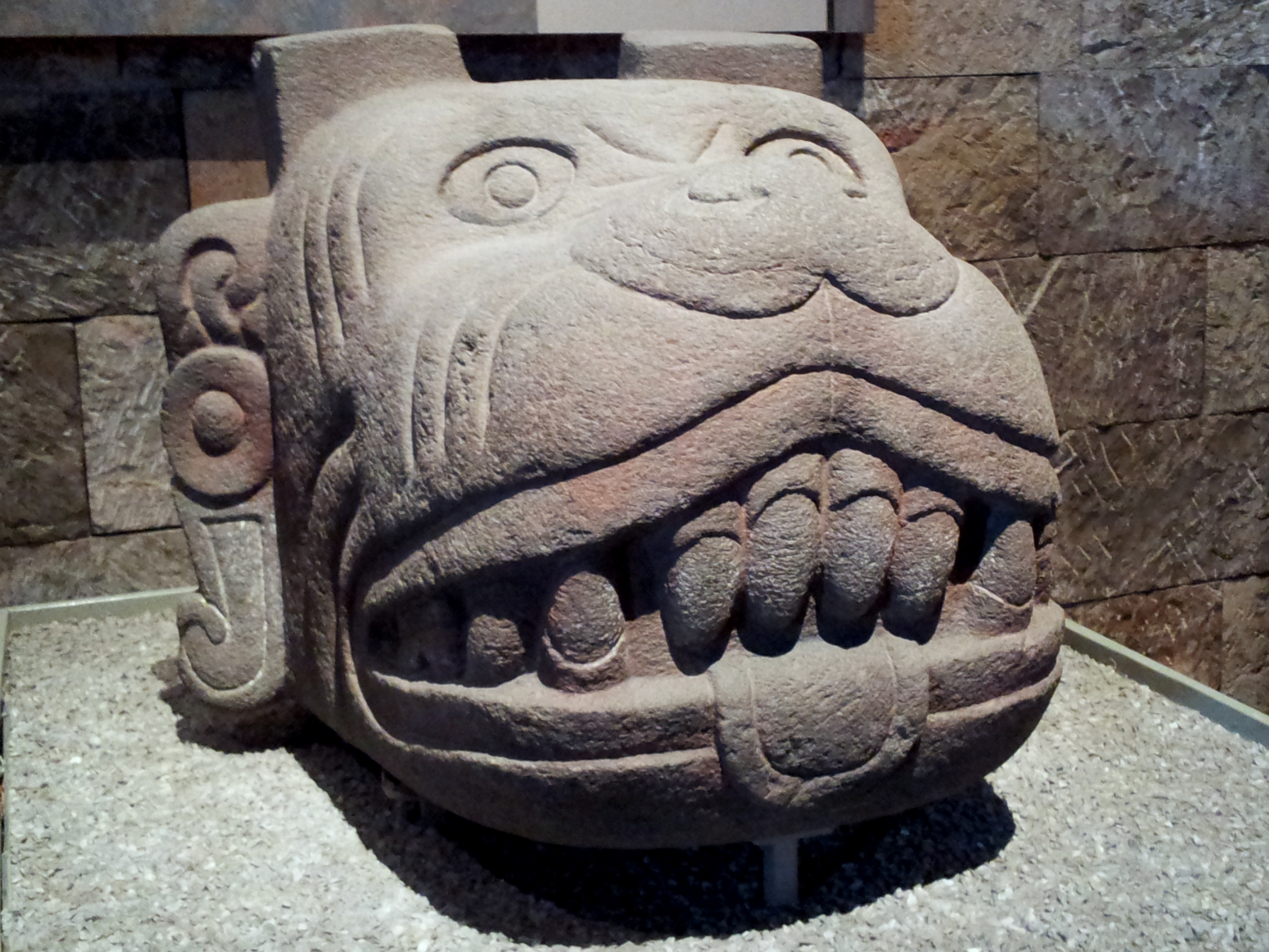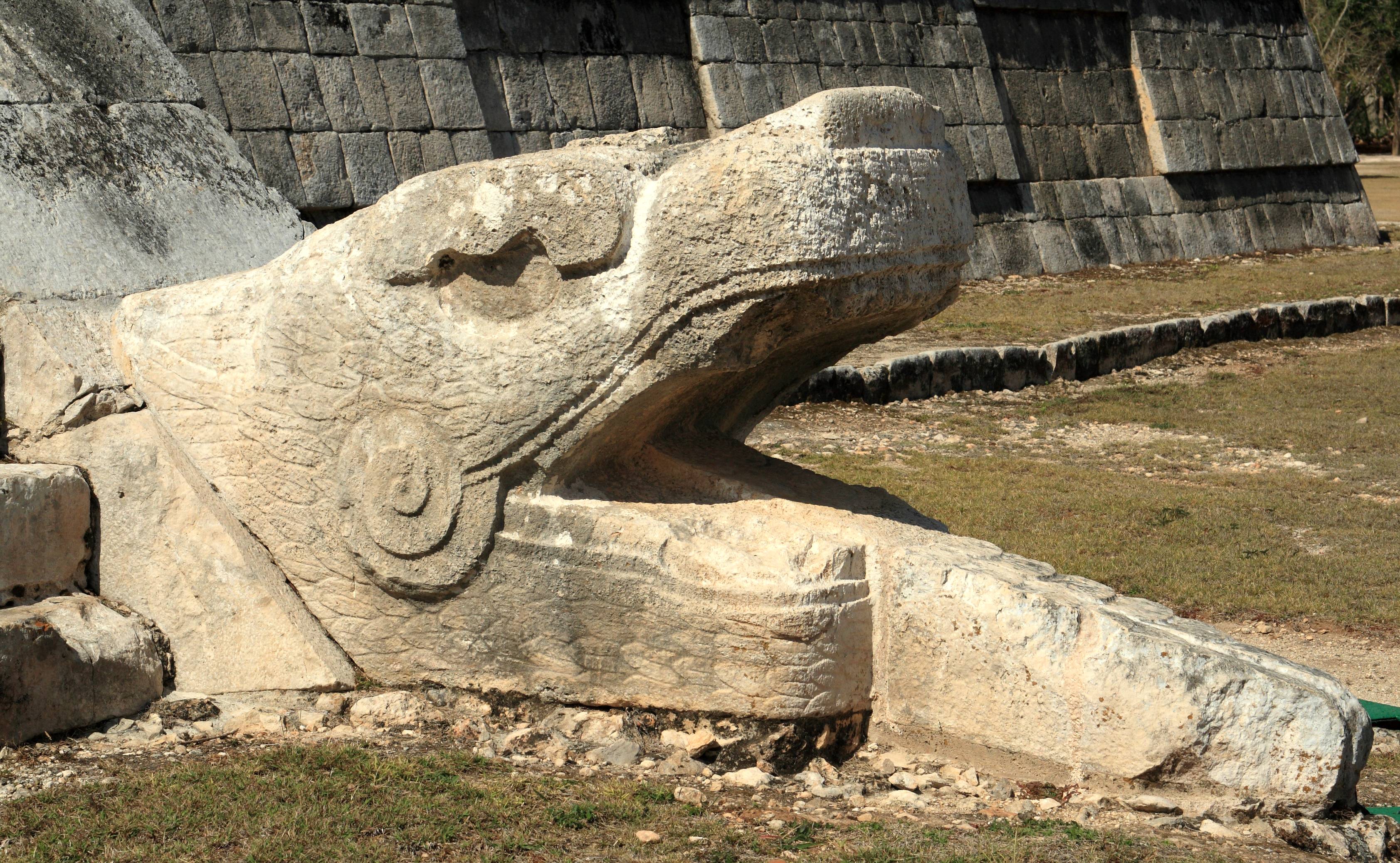|
Quetzlcoatl
Quetzalcoatl (, ; Spanish: ''Quetzalcóatl'' ; nci-IPA, Quetzalcōātl, ket͡saɬˈkoːaːt͡ɬ (Modern Nahuatl pronunciation), in honorific form: ''Quetzalcōātzin'') is a deity in Aztec culture and literature whose name comes from the Nahuatl language and means "Precious serpent" or "Quetzal-feathered Serpent". In the 17th century, Ixtlilxóchitl, a descendant of Aztec royalty and historian of the Nahua people, wrote, "Quetzalcoatl, in its literal sense, means 'serpent of precious feathers', but in the allegorical sense, 'wisest of men'." Among the Aztecs, whose beliefs are the best-documented in the historical sources, Quetzalcoatl was related to gods of the wind, of the planet Venus, of the dawn, of merchants and of arts, crafts and knowledge. He was also the patron god of the Aztec priesthood, of learning and knowledge. Quetzalcoatl was one of several important gods in the Aztec pantheon, along with the gods Tlaloc, Tezcatlipoca and Huitzilopochtli. Two other gods rep ... [...More Info...] [...Related Items...] OR: [Wikipedia] [Google] [Baidu] |
Codex Borbonicus
The Codex Borbonicus is an Aztec codex written by Aztec priests shortly before or after the Spanish conquest of the Aztec Empire. It is named after the Palais Bourbon in France and kept at the Bibliothèque de l'Assemblée Nationale in Paris. The codex is an outstanding example of how Aztec manuscript painting is crucial for the understanding of Mexica calendric constructions, deities, and ritual actions.Keber, Eloise Quiñones. "Borbonicus, Codex." In Davíd Carrasco (ed). .html" ;"title="ol 1">The Oxford Encyclopedia of Mesoamerican Cultures [vol 1/nowiki>">ol 1">The Oxford Encyclopedia of Mesoamerican Cultures [vol 1/nowiki>' . : Oxford University Press, 2001 History The Codex Borbonicus is one of a very few Aztec codices that survived the colonial Spanish inquisition. When the Spanish conquistadors (lead by Hernán Cortés) entered Aztec cities, they would often find libraries filled with thousands of native works. However, most of the works were destroyed during the con ... [...More Info...] [...Related Items...] OR: [Wikipedia] [Google] [Baidu] |
Xolotl
In Aztec mythology, Xolotl () was a god of fire and lightning. He was commonly depicted as a dog-headed man and was a soul-guide for the dead. He was also god of twins, monsters, misfortune, sickness, and deformities. Xolotl is the canine brother and twin of Quetzalcoatl, the pair being sons of the virgin Chimalma. He is the dark personification of Venus, the evening star, and was associated with heavenly fire. The Axolotl is named after him. Myths and functions Xolotl was the sinister god of monstrosities who wears the spirally-twisted wind jewel and the ear ornaments of Quetzalcoatl. His job was to protect the sun from the dangers of the underworld. As a double of Quetzalcoatl, he carries his conch-like ehecailacacozcatl or wind jewel. Xolotl accompanied Quetzalcoatl to Mictlan, the land of the dead, or the underworld, to retrieve the bones from those who inhabited the previous world (Nahui Atl) to create new life for the present world, Nahui Ollin, the sun of movement ... [...More Info...] [...Related Items...] OR: [Wikipedia] [Google] [Baidu] |
Nahuatl
Nahuatl (; ), Aztec, or Mexicano is a language or, by some definitions, a group of languages of the Uto-Aztecan language family. Varieties of Nahuatl are spoken by about Nahua peoples, most of whom live mainly in Central Mexico and have smaller populations in the United States. Nahuatl has been spoken in central Mexico since at least the seventh century CE. It was the language of the Aztec/ Mexica, who dominated what is now central Mexico during the Late Postclassic period of Mesoamerican history. During the centuries preceding the Spanish and Tlaxcalan conquest of the Aztec Empire, the Aztecs had expanded to incorporate a large part of central Mexico. Their influence caused the variety of Nahuatl spoken by the residents of Tenochtitlan to become a prestige language in Mesoamerica. After the conquest, when Spanish colonists and missionaries introduced the Latin alphabet, Nahuatl also became a literary language. Many chronicles, grammars, works of poetry, administrative docu ... [...More Info...] [...Related Items...] OR: [Wikipedia] [Google] [Baidu] |
Mesoamerican Literature
The traditions of indigenous Mesoamerican literature extend back to the oldest-attested forms of early writing in the Mesoamerican region, which date from around the mid-1st millennium BCE. Many of the pre-Columbian cultures of Mesoamerica are known to have been literate societies, who produced a number of Mesoamerican writing systems of varying degrees of complexity and completeness. Mesoamerican writing systems arose independently from other writing systems in the world, and their development represents one of the very few such origins in the history of writing. The literature and texts created by indigenous Mesoamericans are the earliest-known from the Americas for primarily two reasons: Firstly the fact that the native populations of Mesoamerica were the first to enter into intensive contact with Europeans, assuring that many samples of Mesoamerican literature have been documented in surviving and intelligible forms. Secondly, the long tradition of Mesoamerican writing which ... [...More Info...] [...Related Items...] OR: [Wikipedia] [Google] [Baidu] |
Aztec Culture
The Aztecs () were a Mesoamerican culture that flourished in central Mexico in the post-classic period from 1300 to 1521. The Aztec people included different ethnic groups of central Mexico, particularly those groups who spoke the Nahuatl language and who dominated large parts of Mesoamerica from the 14th to the 16th centuries. Aztec culture was organized into city-states (''altepetl''), some of which joined to form alliances, political confederations, or empires. The Aztec Empire was a confederation of three city-states established in 1427: Tenochtitlan, city-state of the Mexica or Tenochca; Texcoco; and Tlacopan, previously part of the Tepanec empire, whose dominant power was Azcapotzalco. Although the term Aztecs is often narrowly restricted to the Mexica of Tenochtitlan, it is also broadly used to refer to Nahua polities or peoples of central Mexico in the prehispanic era, as well as the Spanish colonial era (1521–1821). The definitions of Aztec and Aztecs have long ... [...More Info...] [...Related Items...] OR: [Wikipedia] [Google] [Baidu] |
Deity
A deity or god is a supernatural being who is considered divine or sacred. The ''Oxford Dictionary of English'' defines deity as a god or goddess, or anything revered as divine. C. Scott Littleton defines a deity as "a being with powers greater than those of ordinary humans, but who interacts with humans, positively or negatively, in ways that carry humans to new levels of consciousness, beyond the grounded preoccupations of ordinary life". Religions can be categorized by how many deities they worship. Monotheistic religions accept only one deity (predominantly referred to as "God"), whereas polytheistic religions accept multiple deities. Henotheistic religions accept one supreme deity without denying other deities, considering them as aspects of the same divine principle. Nontheistic religions deny any supreme eternal creator deity, but may accept a pantheon of deities which live, die and may be reborn like any other being. Although most monotheistic religions traditionall ... [...More Info...] [...Related Items...] OR: [Wikipedia] [Google] [Baidu] |
Oxford University Press
Oxford University Press (OUP) is the university press of the University of Oxford. It is the largest university press in the world, and its printing history dates back to the 1480s. Having been officially granted the legal right to print books by decree in 1586, it is the second oldest university press after Cambridge University Press. It is a department of the University of Oxford and is governed by a group of 15 academics known as the Delegates of the Press, who are appointed by the vice-chancellor of the University of Oxford. The Delegates of the Press are led by the Secretary to the Delegates, who serves as OUP's chief executive and as its major representative on other university bodies. Oxford University Press has had a similar governance structure since the 17th century. The press is located on Walton Street, Oxford, opposite Somerville College, in the inner suburb of Jericho. For the last 500 years, OUP has primarily focused on the publication of pedagogical texts and ... [...More Info...] [...Related Items...] OR: [Wikipedia] [Google] [Baidu] |
Lexico
Lexico was a dictionary website that provided a collection of English and Spanish dictionaries produced by Oxford University Press (OUP), the publishing house of the University of Oxford. While the dictionary content on Lexico came from OUP, this website was operated by Dictionary.com, whose eponymous website hosts dictionaries by other publishers such as Random House. The website was closed and redirected to Dictionary.com on 26 August 2022. Before the Lexico site was launched, the '' Oxford Dictionary of English'' and ''New Oxford American Dictionary'' were hosted by OUP's own website Oxford Dictionaries Online (ODO), later known as Oxford Living Dictionaries. The dictionaries' definitions have also appeared in Google definition search and the Dictionary application on macOS, among others, licensed through the Oxford Dictionaries API. History In the 2000s, OUP allowed access to content of the ''Compact Oxford English Dictionary of Current English'' on a website called AskOx ... [...More Info...] [...Related Items...] OR: [Wikipedia] [Google] [Baidu] |
Quetzalcoatl Telleriano2
Quetzalcoatl (, ; Spanish: ''Quetzalcóatl'' ; nci-IPA, Quetzalcōātl, ket͡saɬˈkoːaːt͡ɬ (Modern Nahuatl pronunciation), in honorific form: ''Quetzalcōātzin'') is a deity in Aztec culture and Mesoamerican literature, literature whose name comes from the Nahuatl language and means "Precious serpent" or "Quetzal-feathered Serpent". In the 17th century, Fernando de Alva Cortés Ixtlilxóchitl, Ixtlilxóchitl, a descendant of Aztec royalty and historian of the Nahua people, wrote, "Quetzalcoatl, in its literal sense, means 'serpent of precious feathers', but in the allegorical sense, 'wisest of men'." Among the Aztecs, whose beliefs are the best-documented in the historical sources, Quetzalcoatl was related to gods of the wind, of the planet Venus, of the dawn, of merchants and of arts, crafts and knowledge. He was also the patron god of the Aztec priesthood, of learning and knowledge. Quetzalcoatl was one of several important gods in the Aztec pantheon (gods), pantheon, ... [...More Info...] [...Related Items...] OR: [Wikipedia] [Google] [Baidu] |
Kukulkan
K’uk’ulkan, also spelled Kukulkan, ( "''Plumed Serpent''", "''Amazing Serpent''") is the name of a Mesoamerican serpent deity that was worshipped by the Yucatec Maya people of the Yucatán Peninsula before the Spanish conquest of Yucatán. The depiction of the Feathered Serpent is present in other cultures of Mesoamerica. Kukulkan is closely related to the deity Qʼuqʼumatz of the Kʼicheʼ people and to Quetzalcoatl of Aztec mythology. Little is known of the mythology of this Pre-Columbian era deity. Although heavily Mexicanised, Kukulkan has his origins among the Maya of the Classic Period, when he was known as ''Waxaklahun Ubah Kan'' (), the War Serpent, and he has been identified as the Postclassic version of the Vision Serpent of Classic Maya art. The cult of Kukulkan/Quetzalcoatl was the first Mesoamerican religion to transcend the old Classic Period linguistic and ethnic divisions.Sharer & Traxler 2006, pp 582-3. This cult facilitated communication and peaceful ... [...More Info...] [...Related Items...] OR: [Wikipedia] [Google] [Baidu] |
Toltec
The Toltec culture () was a Pre-Columbian era, pre-Columbian Mesoamerican culture that ruled a state centered in Tula (Mesoamerican site), Tula, Hidalgo (state), Hidalgo, Mexico, during the Epiclassic and the early Post-Classic period of Mesoamerican chronology, reaching prominence from 950 to 1150 CE. The later Aztec culture saw the Toltecs as their intellectual and cultural predecessors and described Toltec culture emanating from Tollan, ''Tōllān'' (Nahuatl language, Nahuatl for Tula) as the epitome of civilization; in the Nahuatl language the word ''Tōltēkatl'' (singular) or ''Tōltēkah'' (plural) came to take on the meaning "artisan". The Aztec oral tradition, oral and pictographic tradition also described the history of a Toltec Empire, giving lists of rulers and their exploits. Modern scholars debate whether the Aztec narratives of Toltec history should be given credence as descriptions of actual historical events. While all scholars acknowledge that there is a lar ... [...More Info...] [...Related Items...] OR: [Wikipedia] [Google] [Baidu] |




.jpg)
.jpg)

